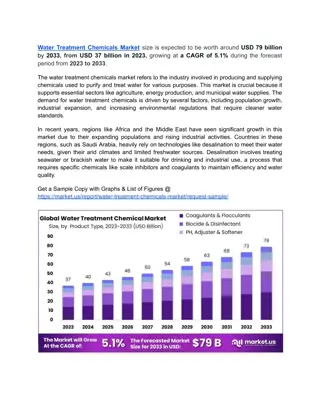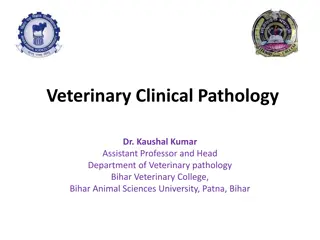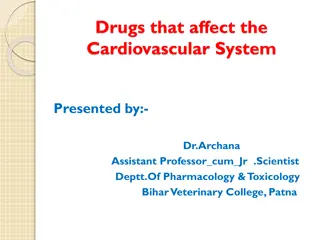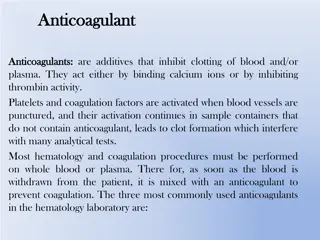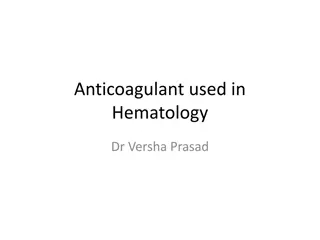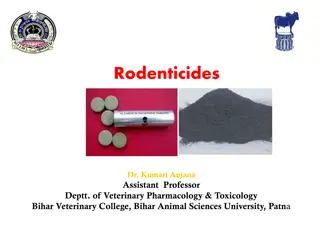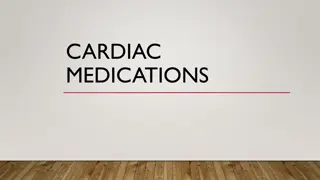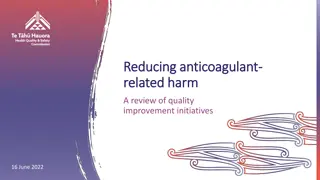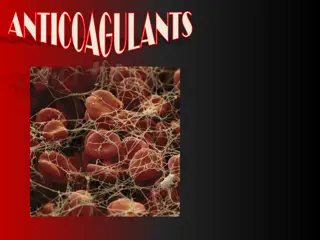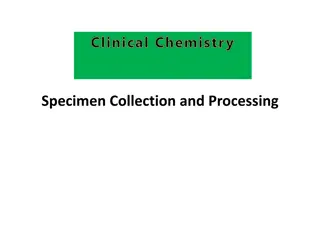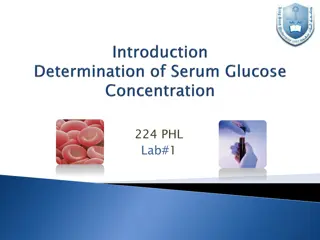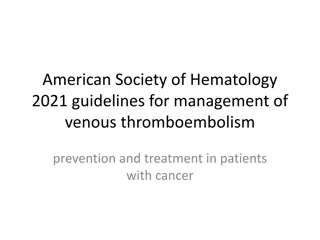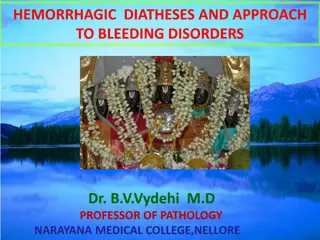
Blood Coagulation Process in the Human Body
Explore the balanced actions of procoagulants and anticoagulants in healthy individuals to maintain blood fluidity, the role of clotting in injury response, and implications of under or overactivity of coagulation factors on health risks.
Download Presentation

Please find below an Image/Link to download the presentation.
The content on the website is provided AS IS for your information and personal use only. It may not be sold, licensed, or shared on other websites without obtaining consent from the author. If you encounter any issues during the download, it is possible that the publisher has removed the file from their server.
You are allowed to download the files provided on this website for personal or commercial use, subject to the condition that they are used lawfully. All files are the property of their respective owners.
The content on the website is provided AS IS for your information and personal use only. It may not be sold, licensed, or shared on other websites without obtaining consent from the author.
E N D
Presentation Transcript
In healthy persons the blood remain in fluid condition because of the balanced actions of procoagulants and anticoagulants present in our body.
It clots only if there is injury to blood vessel so as to stop further bleeding which will result in huge blood loss which will endanger person s life.
If there is under or overactivity of any of this(procoagulant or anticoagulnt) than patient will suffer from illness.
Underactivity of procoagulants and overactivity of anticoagulants will result in bleedng thiases. Underactivity of anticoagulants and overactivity of procoagulants will result in thromboembolic diseases.
COAGULA COAGULAN NTS TS
First step in intrinsic system is contact activation of Hageman factor. Series of cascade reactions finally results in activation of factor X.
In extrinsic system a tissue factor is required but this system results in activation of factor X in seconds within seconds unlike several minutes in intrinsic system.
The subsequent events are common in both systems and results in clot formation.
If both PT and aPTT are prolonged it means there is defect in both the pathways. If only PT is prolonged it means defect is in extrinsic pathway and If only aPTT is prolonged it means defect is in intrinsic pathway.
These are substances which promote coagulation and so reuired in haemorrhagic diseases.
If uncertainty prevails regarding deficiency of a particular clotting factor than whole blood or plasma can be given as it provides all the clotting factors.
VITAMIN K Vit. K is a fat-soluble dietary principle required for the synthesis of clotting factors. Deficiency occurs due to liver disease, obsrtructive jaundice, malabsorption and long term antimicrobial therapy.
The total requirement of Vit. K for an adult has been estimated to be 50 100 g/day.
ACTIONS Vit K acts as a cofactor at a late stage in the synthesis by liver of coagulation proteins - prothrombin, factors VII, IX and X. Changes produced by Vitamin K are essential to work for clotting factors because only after gama carboxylation of clotting factors they can function.
Deficiencies in plasma coagulation factors can cause bleeding. Factor VIII deficiency hemophilia A) and factor IX deficiency (Christmas disease, or hemophilia B) account for most of the heritable coagulation defects. Concentrated plasma fractions and recombinant protein preparations are available for the treatment of these deficiencies. (classic hemophilia or
In following conditions vitamin K is used. 1)Dietary deficiency 2)prolonged antimicrobial therapy 3)Obstructive Jaundice or malabsorption syndromes 4)Liver disease
5) Newborns 6) Overdose of oral anticoagulants 7)Prolonged high dose salicylate therapy
Allergic reactions are rare on oral use. IV route can be hazardous so only oral or im route should be used.
DESMOPRESSIN ACETATE Desmopressin (DDAVP) stimulates the release of von Willebrand factor (vWF) from the Weibel Palade bodies of endothelial cells, thereby increasing the levels of vWF (as well as coagulant factor VIII) 3 to 5- fold. It also used to promote the release of von Willebrand factor in patients with coagulation disorders such as von Willebrand disease, mild hemophilia A and thrombocytopenia.
CRYOPRECIPITATE Cryoprecipitate is a plasma protein fraction obtainable from whole blood. It is used to treat deficiencies or qualitative abnormalities of fibrinogen. It may also be used for patients with factor VIII deficiency and von Willebrand disease.
It has been used in menorrhagia, after termination of pregnancy, PPH, epistaxis, malena, hematuria and after tooth extraction.

